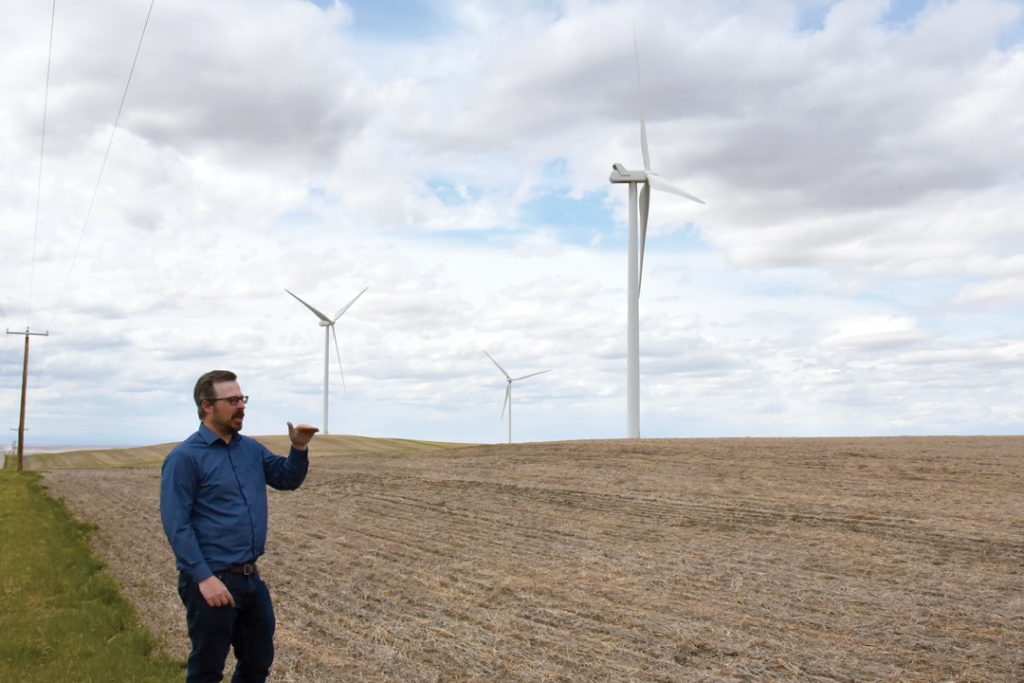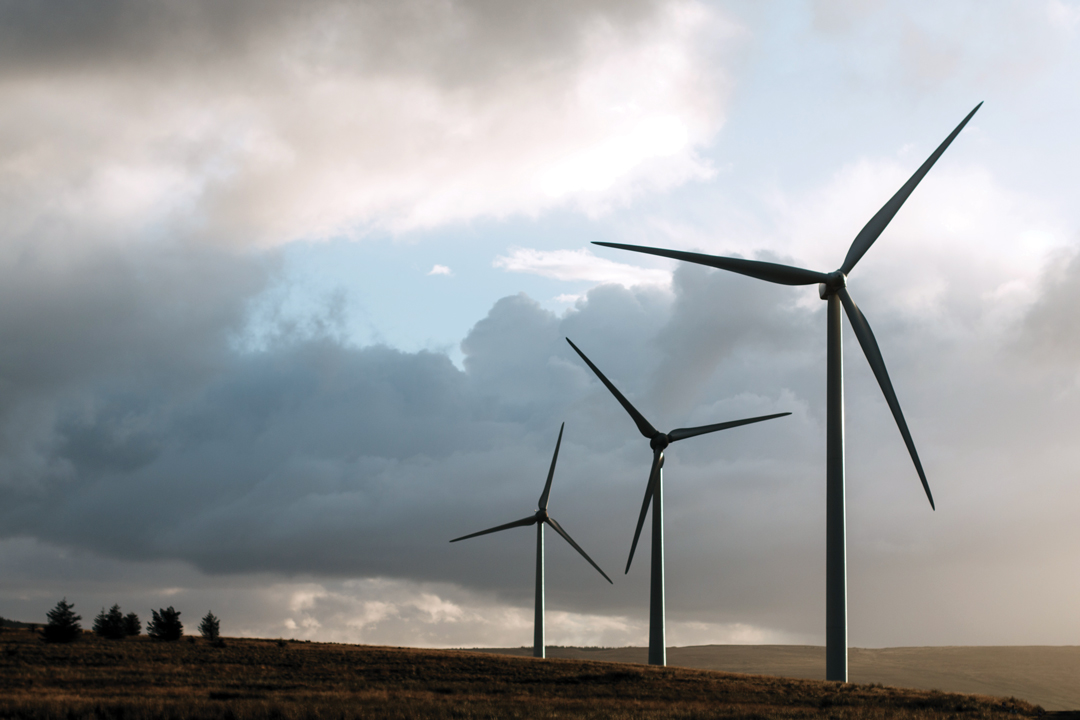POWER PLAY
BY MADELEINE BAERG • LEAD PHOTO BY ZOLTAN VARADI
In February, the Alberta Utilities Commission (AUC) approved ABO Wind Canada’s Buffalo Plains Wind Farm proposal, an 83-turbine project scheduled to begin spinning in farm fields near Lomond in the winter of 2023. The Buffalo Plains project is just one of a surging tide of renewable energy investments proposed for southern Alberta that carries clear benefits as well as potential risks for area farmers.
“I know there are people out there who hear wind and solar [renewable projects] and break out in an allergic reaction,” said Trevor Lewington, CEO of Economic Development Lethbridge. “My advice is not to prejudge. As with anything on your property, whether it’s an oil well, a solar array, a wind tower or an access road, the biggest thing is just to go in with open eyes and an open mind. Do the research and weigh the pros and cons.”
Renewable energy projects bring immediate economic value to the farms and regions where they operate. Most obviously, they offer a potentially lucrative opportunity for farmers to diversify revenue via lease payments.
“If you have a turbine on your land, it’s a pretty good income source. Especially in a dry year like this, if you’re a rancher or farmer and it’s windy every day, it’s a nice diversification,” said Jason Schneider, Vulcan County reeve. “Nobody ever likes to talk too much about the size of the cheque because no one’s sure if everybody’s getting paid something different, but I’d say having a single turbine generally pays about the same as having about five oil wells, so it’s substantial.”
Renewable energy projects also bring substantial tax dollars to the adjacent community. For example, ABO Wind Canada anticipates it will pay more than $3 million in property taxes annually on the Buffalo Plains project, said Jonathan Cooper, senior project manager.
The dollars make a huge difference for the community, said Schneider. “To put it into perspective, at the peak of oil and gas in Vulcan County, oil and gas accounted for about 50 per cent of our overall property tax assessment.” Between this latest project and the two existing projects—Blackspring Ridge Wind Farm and the Travers Solar Project—renewables would eclipse the County’s previous oil and gas property tax assessment.
Large-scale projects carry construction and maintenance employment contract opportunities, though even large projects typically only employ a handful of permanent, full-time staff.
“We expect up to 300 jobs during construction and 10 to 15 permanent local jobs,” said Cooper. “This will also lead to supply chain and contract opportunities for local businesses as well as contract opportunities during construction and operation including excavation, civil works, snow removal, road maintenance, fencing and reclamation.”
Following the corporate trend, ABO Wind Canada recognizes the value of voluntary investment in good neighbour relations. To this end, Cooper said the company plans to institute a Green Option program, which will provide annual payments to eligible landowners living within two kilometres of a Buffalo Plains turbine. He added the program will distribute around $1 million to local landowners over the lifespan of the project. The company also intends to create a Community Vibrancy Fund to provide and update public facilities in the surrounding area, an investment Cooper said will eventually contribute more than $600,000 to local community projects.
Renewable energy projects such as Buffalo Plains also bring less obvious benefits. These may include road improvements and spinoff investment in economic diversification. There are also less concrete potential benefits. “Regardless of what your business is, if you’re a company that wants to be able to say, ‘We source our energy from renewable sources,’ then southern Alberta is a great place to set up operations,” said Lewington. “You can sign power purchase agreements and say you’re physically located right where that power is generated. Over time, sustainability is only going to become more of a focus and will very likely drive more investment in this region.”
Benefits aside, renewable energy projects can be unpopular with neighbours. Wind turbines are topped with flashing lights, produce shadow flicker and face complaints of “visual pollution.” Opponents argue renewable energy isn’t necessarily environmentally positive. Rotors are a risk to bats and birds, and the required infrastructure may take more power to build than it can produce in its usable lifetime. Increasingly, some question the long-term cost of using farmland for renewable energy production.
Landowners who host the projects carry the greatest risk. Some contracts are established without a clear end date, which means a landowner who no longer wants the project on their property may have no legal right to affect its removal. Potentially worse, landowners may find themselves saddled with defunct solar or wind energy infrastructure and on the hook for reclamation. There are no legislated reclamation rules to protect the landowner if a renewable energy company walks away from a project. There is also no third-party support for the landowner if one of these companies goes belly up.
“So, if you’re signing a land lease, you better understand what it is that company is responsible for, and what you are responsible for. Those are the kinds of things you need to get expert help on,” said Lewington.
Many argue the provincial government needs to force companies to complete remediation plans as good or better than what is in place for oil and gas. “Comments have been made that the reason [government] won’t put these kinds of projects onto public lands is because they’re worried about the cleanup, but they’re happy to let it happen on private land,” said Schneider. “I hope it’s something that gets a little more focused [consideration] at the provincial level because it’s not something the Province has been too interested in getting involved with.”
The Buffalo Plains project is Vulcan County’s third green energy project. Spread across 7,100 hectares (17,500 acres), the wind farm should produce 500 megawatts of energy per day, enough to supply more than 100,000 homes with clean energy. ABO Wind Canada is just one of many companies drawn by southern Alberta’s wide open landscape, consistent sunlight, wind and competitive electricity market.
Renewable energy projects now provide 2,269 megawatts of energy from wind and 892 megawatts from solar. This is just the start, said Leif Sollid, Alberta Electric System Operator (AESO) communications manager. “Projects under construction coming online in the next year or so include 1,530 megawatts of wind and 822 megawatts of solar—a very significant increase in renewable power generation in Alberta.”
In fact, there is so much investment interest, the potential for Alberta’s electricity sector to reach net-zero emissions through renewable power generation isn’t far-fetched. Alberta’s entire power grid produces 16,000 megawatts of energy per day. If all the 138 renewable energy projects in the queue were approved, their combined output would equal this number. These projects represent about $20 billion worth of investment, said Lewington.

To be clear, only about one in 10 projects typically passes the regulatory approval process. “Not all of those projects are going to happen right now,” added Lewington. “They might not necessarily be viable today, but in another five or 10 years as markets shift, some of those might come back on the books.”
AESO is drafting a report that will outline how the province’s electricity production sector can achieve a net-zero target by 2035, said Sollid. He added that one key step to net-zero will be the creation of utility-scale battery farms to better manage the intermittency inherent in wind and solar energy production.
Could a renewable energy project be a good fit for your farm or community? “Farmers and ranchers are intelligent businesspeople,” said Lewington. “Many have very large, complex operations; they manage an awful lot of variables and a complex regulatory environment every single day. For the right people in the right circumstance, with due diligence, the right tools, the right experts and advisors, it can be very beneficial.
“The energy transition is not going away,” he added. “So, the question then becomes: How is Alberta going to play in that market and stay competitive globally?






Comments